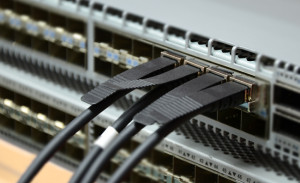 SFP+ direct attach copper (DAC) cables and 10GBASE-T SFP+ are two main options to transmit 10Gbps signals over copper cabling. But how does SFP+ DACs vs 10GBASE-T SFP+?
SFP+ direct attach copper (DAC) cables and 10GBASE-T SFP+ are two main options to transmit 10Gbps signals over copper cabling. But how does SFP+ DACs vs 10GBASE-T SFP+?
Direct Attach Cables (DAC) are high performance integrated duplex data link for high-speed data transmission. SFP+ DACs, also known as SFP+ Twinax cables, uses SFP+ MSA and copper “twinaxial” cable with SFP+ connectors on both sides, providing 10 Gigabit Ethernet connectivity between devices with SFP+ interfaces. SFP+ Direct Attach Copper Cable is expected to be the optimum solution for 10G Ethernet reaches up to 15 m (1-7m passive, up to 15m active).
10GBASE-T, or IEEE 802.3an-2006, is a standard released in 2006 to provide 10 Gbps connections over unshielded or shielded twisted pair cables, over distances up to 100m. Category 6a is required to reach the full distance of 100m and category 6 may reach a distance of 55m depending on the quality of installation, determined only after re-testing to 500 MHz. The new 10GBASE-T SFP+ transceiver delivers the flexibility and port density well known to the SFP+ form-factor, utilizing Cat 6a UTP structured cabling for network connectivity. It is a power optimized solution for lengths up to 30m, engineered to deliver a minimum power saving of at least 0.5W per port compared to an equivalent embedded 10GBASE-T RJ45 for the same length (Cat6a cable, up to 30m). These power savings can add-up in ToR, mid-row and end-of-row switch connectivity. Implemented as an SFP+ form factor, the new 10GBASE-T transceiver module also delivers a pay-as-you-grow option.
1. 10GBASE-T commonly used for 10MB, 100MB and 1GB network connections, while SFP+ Direct Attach Cable only for 10Gigabit Ethernet Network. And 10GBASE-T also support much longer distances than SFP+ Direct Attach Copper Cable.
The concept of standard, structured cabling provides a long-term underlying foundation of transmission infrastructure that follows a base set of engineering rules. 10GBase-T retains and abides by this by operating over the installed base of twisted-pair copper cable already in place for lower-speed applications. 10GBase-T uses the same cabling-link-negotiating concepts as do 1GBase-T, 100Base-T and 10Base-T, providing a clear path of bandwidth upgradeability as needed, by leveraging the existing pair infrastructure. Within a rack, following link segment specifications, the same 10GBase-T copper twisted-pair cabling will enable use with earlier Ethernet generations – 10MB, 100MB and 1GB operation. To extend this further, this same copper twisted-pair cabling is utilized outside the equipment distribution area (EDA) zone, connecting with horizontal distribution area in the data center.
As a technology, 10GBase-T enables network managers to preserve their knowledge base of Ethernet transport while seamlessly upgrading bandwidth capacity from 1G to 10G rates. Additionally, network managers preserve their underlying investment in the maintenance of standard, structured cabling systems.
The IEEE 802.3an-2006 10GBase-T Ethernet Standard specifies operation over standard, structured twisted-pair copper cable up to 100 meters. In contrast, 10G SFP+ Direct Attach is limited to 10 meters, with a reach of five to seven meters more commonly available. SFP+ Direct Attach cables longer than five meters are exponentially higher cost compared to shorter cables.
2. 10GBase-T offers the ability to field-terminate, while SFP+ Direct Attach cables cannot be field-terminated.
As a standard, structured cabling system, twisted pair cables are a known technology to data center cable technicians. Twisted pair cabling offers the ability to field-terminate, as needed, clean lengths in less than a minute. 10GBase-T implementations enable just such a clean, structured cable infrastructure.
SFP+ Direct Attach cables, in contrast, cannot be field-terminated. SFP+ uses a passive twin-ax cable assembly and connects directly into a SFP+ housing; they are specially terminated at the vendor site and must be purchased at pre-determined lengths. This adds overhead to cable management inventory, while preventing a clean, efficient cable infrastructure design.
3. Power Dissipation of 10GBase-T is higher than SFP+ direct attach cable.
At a physical layer (PHY) device level, 10GBase-T power consumption, whether at full 100-meter reach or 30-meter short reach mode, will be higher than SFP+ Direct Attach, including the electronic-dispersion-compensation chip. A 10GBase-T PHY, at the device level, can consume anything from two to four Watts per port compared to two Watts per port for SFP+ Direct Attach.
SFP+ direct attach cables are widely used in varies condition for short distance 10G transmission, and 10GBASE-T works with Cat 6 and Cat7 cable that are commonly used for 1Gb network connections, which all have their own special applications.



